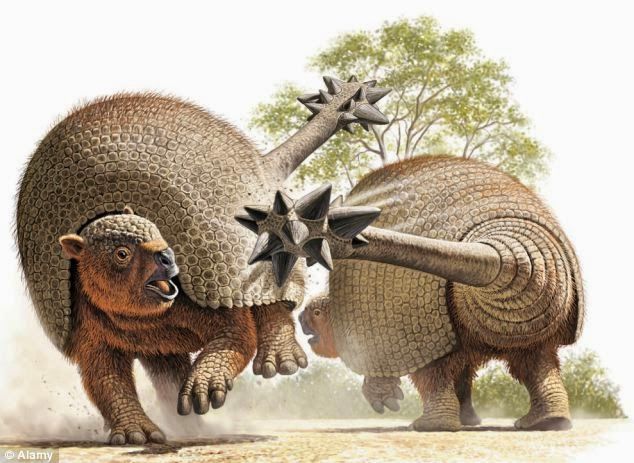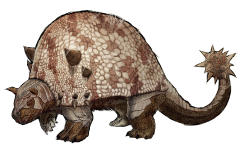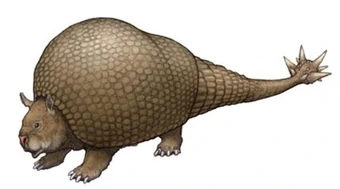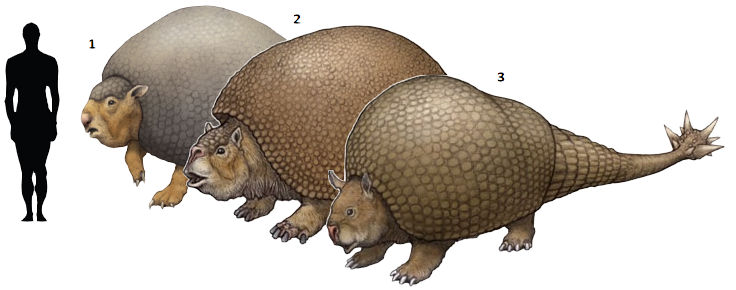Pestletail
"The vewavs are our life, our blood. If we didn't have them to feed us, clothe us, and guide us, then the Czhahyl would be as lost as the wandering dead, and at worst the stagnant dead of ourselves."
~Hetman Llor of the Wild Buckaroos
Vewavs are also known as 'pestletails' and 'chunkbacks.'
Basic Information
Anatomy
Vewav are giant rodents with a large humped back, leather plates for armor, and a spiked ball on their tails.
Genetics and Reproduction
Vewavs reach mating age in two years, and can conceive or bear children for roughly twenty years after. Females produce leathery eggs monthly, and can identify fertilized eggs by smell. If a fertilized egg is laid, the females tuck it into a pouch on their soft underbelly until it hatches, at which time it continues to live in the pouch until it has grown enough to be self-sufficient. Teats in the pouch produce milk which feed the whelps.
Growth Rate & Stages
For the first six months of its life after hatching, a vewav is a whelp. It drinks milk and is entirely dependent on its mother. After it emerges from this pouch, it takes six months to grow during which time the adolescent vewav is ravenous and ready to eat any plant it can comfortably chew. During this time, its tail begins to develop a club. When it reaches adulthood, this club grows keratin spikes that it uses for self defense and to compete for mates. After breeding age, the vewav becomes an 'elder vewav', wherein their leather shells become increasingly hard until finally they cannot breathe anymore and they simply curl up into a ball to die, usually between ages 20-30. Vewav that die of old age this way can be found scattered throughout the wilderness like boulders.
Ecology and Habitats
Vewav herds have a reputation for shutting down roads, as they prefer to travel on the paths of least resistance. Other than that, they live in forests and rolling plains, and shun the mountains.
Dietary Needs and Habits
Vewav are herbivores with extremely robust three-part stomachs. They eat grass, wheat, fallen leaves, pine needles, mushrooms, and any other plant or fungus that their low-slung heads can reach.
Biological Cycle
Vewav are migratory animals, travelling north in the summer and south in the winter. On Seaudyr, this means that they are a common sight everywhere but the Badlands or The Barrier Mountains.
Additional Information
Social Structure
Vewavs exist in herds that can reach populations of several thousand in good years. There is no leader, they think simplistically and uniformly enough that the herds can move as one.
Domestication
Vewav can be domesticated, though their migration instinct is too strong to keep them on farms. The Czhahyl can tame them, using them to pull some of their carts while following the rest of the herd for hunting.
Uses, Products & Exploitation
While the Czhahyl have a liquor made from fermented vewav milk, the unprocessed milk's red-brown color and pickled fish flavor make drinking it more of a dare than a viable beverage.
The abandoned unfertilized eggs can be harvested to make a soft leather from the shell, as well as a bacon-like delicacy (fried in butter) and of course the yolk is good for omelettes. If left alone, they are the primary host of slumbershaf mushrooms, which the Czhahyl form into a variety of inebriants and sleep aid medicines.
Adult and especially elder vewav are hunted for their shells and meat. The former can make a thick rawhide that resists heat and piercing, while the latter make chitinous plates that the Czhahyl mount on their wagons as lightweight armor. The bones are also useful for building and tooling, and when ground can make a slightly subpar flour substitute or valuable fertilizer.
Facial characteristics
Vewavs have large noses, whiskers that range from a few inches to a foot bast the full width of their bodies. They have scissor like incisors and robust grinding teeth that never stop growing, to offset the erosion of their gritty diets.
Geographic Origin and Distribution
Vewavs can be found seasonally throughout Seaudyr, and smaller breeds of them are common among the explored islands of Kobos.
Perception and Sensory Capabilities
Vewavs have poor eyesight in the light, worse in the dark, and are basically blind at dawn and dusk. Their hearing is on par with humans', but their sense of smell is slightly better. They are color blind.
Symbiotic and Parasitic organisms
In rare cases, vewavs can become the hosts of arcanohelminths, presenting a serious challenge for hunters.
Scientific Name
Vewav
Lifespan
20-30 years
Average Height
5 ft. from floor to the top of the hump.
Average Weight
4200 - 5200 lbs
Average Length
13 ft.
Body Tint, Colouring and Marking
Vewavs can be any shade of brown (their name means simply 'brown' in The Old Tongue. The most prized Vewavs by hunters are 'calico,' exhibiting panels and spots of differing shades of brown.







Comments